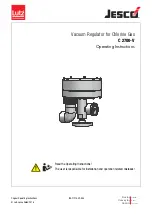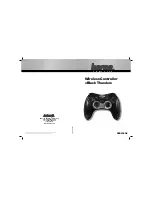
Installation
Installation location
12
Vacuum Regulator for Chlorine Gas
C 2700-V
© Lutz-Jesco GmbH 2016
Operating Instructions
BA-21210-02-V05
6 Installation
6.1 Installation location
Based on the chlorine direction of flow, the vacuum regulator is the final
device in the installation which is operated with overpressure. For this
reason, the vacuum regulator must be installed in the chlorine supply
room which is monitored by a gas warning device (see "Installation
examples" on page 16).
All the subsequent devices and lines in the direction of flow operate at
negative pressure compared to the atmosphere. These devices are
normally installed in the dosing device room.
The device must not be exposed to direct sunlight.
6.2 Mounting position
The device input must point downwards.
Fig. 6-1: Mounting position
6.3 Installing the device
6.3.1 Chlorine input (pressure line)
The vacuum regulator should be installed directly on the supply line. It
can be carried by the line and thus does not have to be fixed separately.
However, the line should be sufficiently secured.
The line from the chlorine barrel to the vacuum regulator must be laid
so as to ascend continuously.
A shut-off valve should be fitted upstream of every vacuum regulator.
Seamless pipes with a nominal diameter of DN25 (1") made of non-alloy
carbon steel are used as pressure lines. A larger pipe only has to be
used for very long distances or if several vacuum regulators are
connected to a joint supply line.
The following nominal diameters are recommended for the pressure line
(pressure drop of a maximum of 0.5 bar, max. speed of 20 m/s, calcu-
lated at 1.5 bar with 4x90° angles):
WARNING
Increased risk of accidents due to insufficient qualifica-
tion of personnel!
Chlorinators and their accessories must only be installed, operated
and maintained by personnel with sufficient qualifications. Insuffi-
cient qualification will increase the risk of accidents.
Ensure that all action is taken only by personnel with sufficient
and corresponding qualifications.
Prevent access to the system for unauthorised persons.
NOTICE
Damage to the system due to incorrect installation
Failure to comply with the installation instructions (e.g., use of
unsuitable tools, incorrect torques) can damage the system compo-
nents.
Only apply the appropriate amount of force to plastic compo-
nents! Plastic threads (especially PVC threads) can be tightened
and loosened more easily by applying a thin layer of silicone or
PTFE grease to them beforehand.
Observe the following torques:
NOTICE
Damage to the system due to liquid chlorine
The vacuum regulator is only suitable for gaseous chlorine. Liquid
chlorine destroys PVC components.
Install a chlorine evaporator upstream of the vacuum regulator
if liquid chlorine is used. An additional pressure-reducing valve
prevents condensation of the chlorine gas in the installation
downstream of the chlorine evaporator.
In the case of systems without pressure-reducing valves, the
highest temperature must be in the line directly before the
vacuum regulator. This is achieved by heating up the line
directly upstream of the inlet valve with a heating collar or by
equipping the entire pipe line with a heating belt. This prevents
the condensation of chlorine gas.
Install a moisture eliminator with a heating collar at the vacuum
regulator input to evaporate residual quantities of liquid chlorine.
Mass chlorine
flow
Length of pressure line
10 m
20 m
30 m
50 m
100 m
150 m
80 kg/hr
DN25
DN25
DN25
DN25
DN25
DN25
120 kg/hr
DN25
DN25
DN25
DN25
DN25
DN32
200 kg/hr
DN25
DN25
DN25
DN32
DN32
DN32
400 kg/hr
DN32
DN32
DN32
DN40
DN40
DN50
600 kg/hr
DN40
DN40
DN40
DN40
DN50
DN50













































